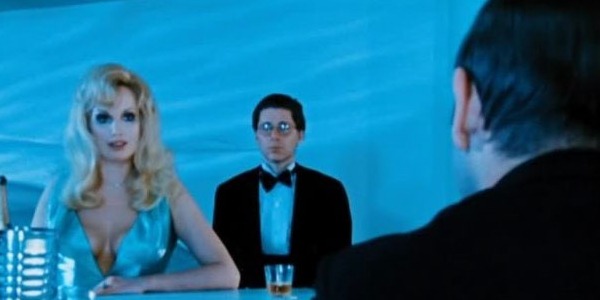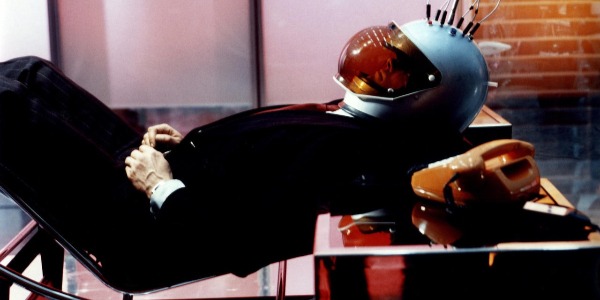WORLD ON A WIRE: Second Sight’s Simulacrum

Alex is a 28 year-old West Australian who has a…
When The Thirteenth Floor, a largely forgotten sci-fi film was pushed out in 1999 in the aftermath of The Matrix’s revolutionary success, the general public couldn’t have guessed that it was actually a misconceived remake of Rainer Werner Fassbinder‘s game-changing World on a Wire, a dystopian sci-fi epic that laid down the groundwork for films like The Matrix to exist in the first place.
Originally aired as a two-part television serial back in 1968, the 3 and a half hour anomaly was adapted from Daniel F. Galouye’s 1964 novel Simulacron-3, one of the first pieces of American literature to hypothesise about simulated reality. It’s a philosophical argument that has provided the basis for a number of beloved science-fiction stories; whether on the pages of Philip K. Dick, or the films they both clearly inspired; from Inception, The Truman Show, Dark City, Blade Runner and hell, even children’s entertainment like Wreck it Ralph.
This level of existential interrogation was nothing new for the West German filmmaker – neither was working within the restrictive reigns of television – but what was different was the genre he was employing. Tackling science-fiction was (literal) worlds away from the claustrophobic domestic spaces that his actors (who returned for this venture) usually inhabited, and whilst this isn’t quite like the action-packed thrillers that it eventually inspired, it could at face value be best described as Sergio Leone‘s most experimental episode of Man From U.N.C.L.E.
An Idea of an Idea of an Idea
Resurrected by Second Sight Films, who have given European audiences a chance to catch-up on the previously lost formative text (gone for 45 years, till the US-locked Criterion Collection saved it from obscurity), World on a Wire is the rare 70’s television film that defies its medium, with the only indication of its original release being its two-part cliffhanger structuring. Although, for a movie with such a lengthy runtime, this awkward framework actually works in its favour. In modern terminology, think of it as binging a terrific Netflix series; spreading it over two nights is always better than splurging in one go.

It’s also a lot to take in – both aesthetically and thematically – transcendental layers of character, plot and ideology largely delivered within stuffy, smoke-filled rooms of 70’s chic furniture, which doesn’t exactly sound like a fun night in. But within the highly capable hands of Fassbinder, who miraculously shot this back-to-back with his most defining feature, Ali: Fear Eats the Soul, any audience member, whether an educated fan of the director or just a newcomer filling in a major gap of fundamental science-fiction history, will find themselves gracefully enraptured by the esteemed social-realist auteur’s interpretation of this cerebral chaos.
Presented within the Academy ratio (1:37:1 aspect ratio, which adds black bars to the left and right sides of the screen), World on a Wire begins within the building of the Institute for Cybernetics and Future Science, a government institution established in an undetermined future in Paris. The futuristic setting is defined by cleverly redressing old Parisian buildings and costuming the various characters in 1940’s American noir outfits, yet still littered with cultural iconography of the late 60’s that Fassbinder was currently thriving within; the offices. Those who work within them are barren and stark, living in the cold shadow of postwar Germany, with every civilian either holding a smoke, a drink, or both, in each hand, existing in an oscillating state of distrusting any authoritative figure but also beholden to their rigid ideals.
Vollmer, the technical director of the Institute, has just finished a monumental development on a brand new computer system – titled the Simulacron – which has the ability to create a computer-generated world filled with a countless number of “identity units”, avatars who believe themselves to be real people. In Fassbinder’s numb world, nobody is excited or awed by what this means, it’s merely seen as another opportunity for advertisers to exploit the technology to see how their products function in a hypothetical society (predicting an alarming intersection of politics and consumerism that obviously weighs heavily on the director’s brow).

When Vollmer suddenly drops dead, his replacement Fred Stiller (a stone-cold Klaus Lowitsch) takes over, suspicious that his previous president’s mysterious death might mean something, a suspicion intensified when another colleague Günther Lause (Ivan Desny) says that Vollmer died because of a secret he learnt, only for himself to bizarrely disappear too.
The film’s first half revolves around Stiller’s investigation, juggling the office politics of his demanding job with his pragmatic approach to a situation that slowly unravels his own reality around him – the visuals of Stiller’s world and the one he created are virtually indistinguishable for a reason – and when he finally finds the key secret that kickstarted this case, his sanity is instantly shattered, discovering a whole new perspective on life that forces his sabotage of a static system into overdrive.
This journey is beautifully captured by Fassbinder’s go-to DP Michael Ballhaus (with assistance from Ulrich Prinz), whose camera is constantly moving, whether it be Spaghetti-Western-esque crash zooms, grand arc shots or just simple but effective dolly shots, boldly following the key characters throughout every situation, heightening the God-like gaze that the characters are caught within. The grainy photography is merely indicative of its time (shot on 16MM film), and this remastering, supervised by The Rainer Werner Fassbinder Foundation and Ballhaus himself, is the clearest conversion that this film has – or will – ever receive.
The film’s carefully curated mise-en-scene, often framing actors within prisms of glass or mirrors, eschews any traditional models of blocking and staging of action; gone is the typical American cinematography layout shooting every conversation with two over-the-shoulder close-ups and one wide, instead, in a manner which intensifies the sterility of the simulated world, favours dense long shots, ingeniously fitting every relevant speaking actor within the frame. Basic discussions between three men in a cramped office become dynamic setpieces thanks to the balletic control of camera. Or as Canadian film critic Justin DeCloux so succinctly put it, he can “carefully frame the most non-descriptor shot in the most beautiful way”.
The Box Set Specials
This Limited Edition Blu-Ray Box Set is a major step above the previous Criterion release – despite porting one of its extras over – forgoing a standard clear Blu-ray case in favour of a rigid slipcase packaging, which houses the film on two seperate discs, alongside a 50-page booklet (this wasn’t sent to myself, but it includes new essays from Anton Bitel, Daniel Bird, Daniel Oberhaus and Christian Braad Thomsen, bolstered by stills and rare on-set photos).
The thorough supplements give incredible context to not only this film, but Fassbinder itself, and how his work on this eventually affected the rest of his career. “Looking Ahead to Today”, a fifty-minute featurette dedicated to the making of the movie, is the sole main extra of Criterion’s old release, and well worth watching to see how something this strange – and ultimately influential – came to be, reflecting on a time where an obscure arthouse director could make and air a television mini-series this surreal and sardonic (nowadays this type of material is saved for streaming services or one-off HBO events).

“The Simulation Argument” has Professor Nick Bostrom delivering a detailed 20 minute dissection of the film’s depiction of simulated reality, extrapolating the hypothesis into accessible terminology that helps flesh out the ideas presented in the sci-fi story. “Observing Fassbinder” is equally informative, a slick tribute to photographer Peter Gauhe and how his work informed Fassbinder’s distinctive style.
“No Strings Attached” is the disc’s most personal entry, a lovely 30 minute interview with Renate Leiffer, Fassbinder‘s childhood friend and frequent collaborator (whose positions on his films ranged from script supervisor to assistant director), discussing her relationship with the often-maligned director and how production of World on a Wire – from the actors to how Fassbinder planned his composition – went down through her eyes. It’s an illuminating and quite rare examination at a side of the director that we rarely see; many peers often regard his style as one of being a prickly perfectionist, mistreating both his cast and crew, so seeing an alternative perspective provides a nuanced take on a man who we lost tragically too soon.
World on a Wire: Conclusion
The legacy of Rainer Werner Fassbinder looms large over cinema, producing over forty feature films, two television series and much more in just under two decades, and despite the various Criterion/boutique releases of his many features, there’s still many undiscovered gems lurking throughout his prolific career still yearning to be found.
Second Sight’s revival of World on a Wire is vital for not only highlighting one of his more underrated efforts, but for resurrecting one of the essential texts of science fiction, a reflection on a film filled with reflections. This release is a crucial purchase for Fassbinder fans and science-fiction buffs alike – I can surely bet that the Wachowski’s would say the same.
What do you think of the works of Rainer Werner Fassbinder? Let us know in the comments below!
Second Sight Films’ release of World on a Wire is due to be released in the UK on February 18th, which is available from Amazon UK.
Does content like this matter to you?
Become a Member and support film journalism. Unlock access to all of Film Inquiry`s great articles. Join a community of like-minded readers who are passionate about cinema - get access to our private members Network, give back to independent filmmakers, and more.













